Ethical Dilemma in Accounting: ABC Learning Centre Case
VerifiedAdded on 2019/11/12
|7
|2081
|157
Report
AI Summary
This report analyzes the ethical issues that led to the downfall of the ABC Learning Centre, a major Australian educational company. The report highlights the importance of ethical conduct in accounting, particularly focusing on the responsibilities of auditors and the impact of unethical decisions on financial reporting and stakeholders. It examines how falsified financial reports and compromised auditor independence contributed to the company's liquidation. The analysis includes a discussion of the ethical dilemmas faced by auditors and the consequences of failing to maintain professional skepticism and unbiased opinions. The report emphasizes the need for transparency, accurate financial statements, and the protection of investor interests. It explores the case's implications for corporate governance and the importance of ethical practices in preventing financial scandals. The study highlights the critical role of ethical decision-making in maintaining the integrity and sustainability of businesses.
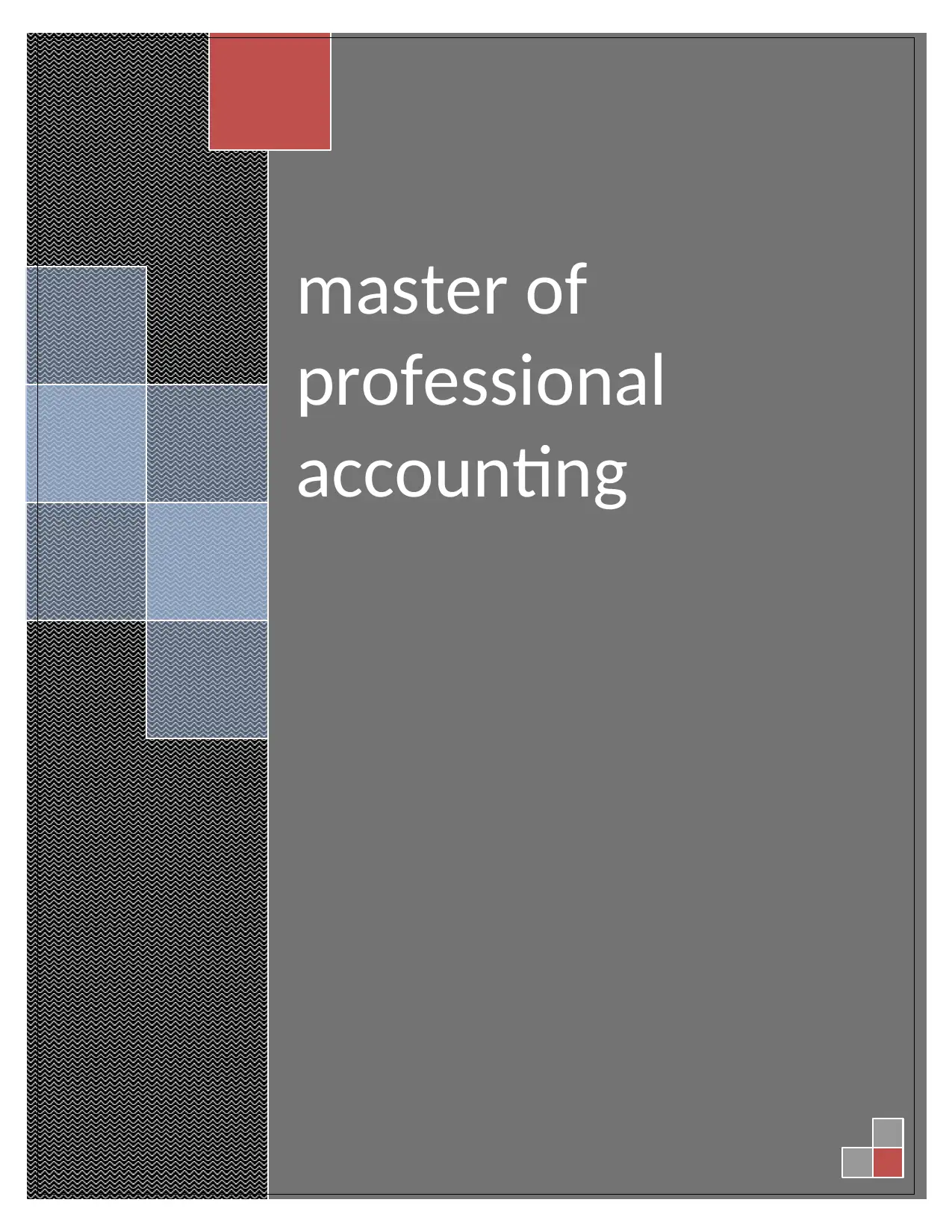
master of
professional
accounting
professional
accounting
Paraphrase This Document
Need a fresh take? Get an instant paraphrase of this document with our AI Paraphraser
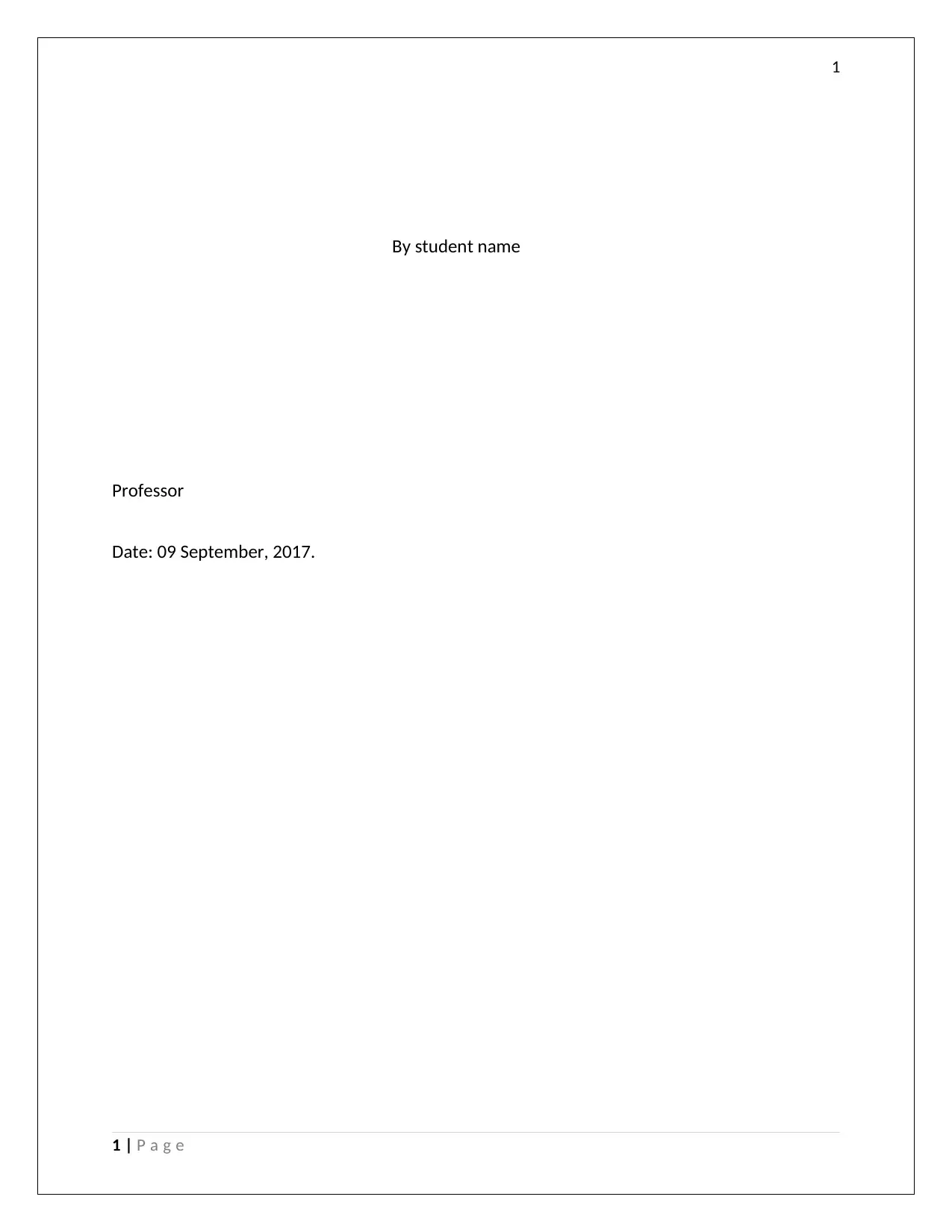
1
By student name
Professor
Date: 09 September, 2017.
1 | P a g e
By student name
Professor
Date: 09 September, 2017.
1 | P a g e

2
Contents
Introduction……………………………………………………………………………………………..........…..3
Analysis……………………........................................................................................... 3
Conclusions..........................................................................................................5
References............................................................................................................ 6
2 | P a g e
Contents
Introduction……………………………………………………………………………………………..........…..3
Analysis……………………........................................................................................... 3
Conclusions..........................................................................................................5
References............................................................................................................ 6
2 | P a g e
⊘ This is a preview!⊘
Do you want full access?
Subscribe today to unlock all pages.

Trusted by 1+ million students worldwide
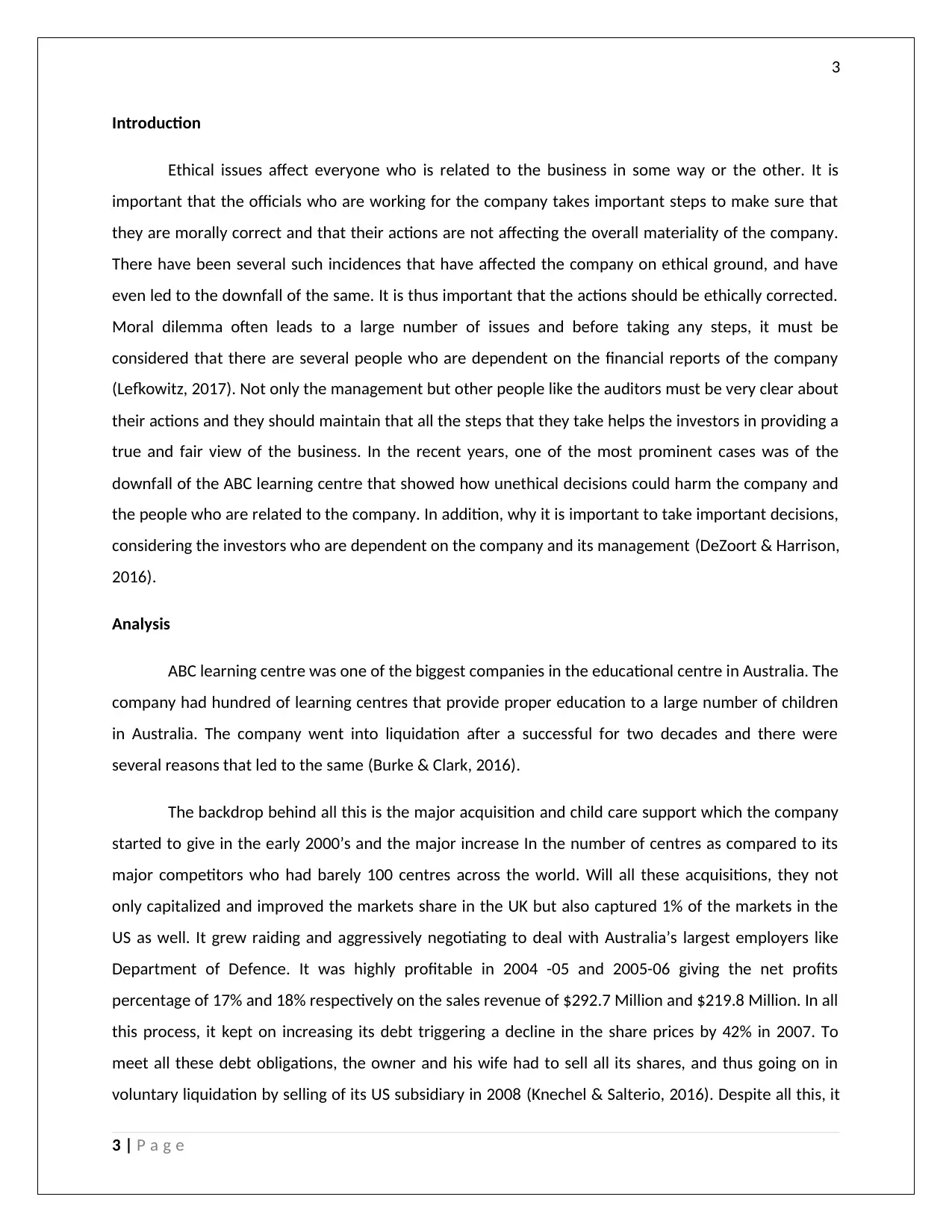
3
Introduction
Ethical issues affect everyone who is related to the business in some way or the other. It is
important that the officials who are working for the company takes important steps to make sure that
they are morally correct and that their actions are not affecting the overall materiality of the company.
There have been several such incidences that have affected the company on ethical ground, and have
even led to the downfall of the same. It is thus important that the actions should be ethically corrected.
Moral dilemma often leads to a large number of issues and before taking any steps, it must be
considered that there are several people who are dependent on the financial reports of the company
(Lefkowitz, 2017). Not only the management but other people like the auditors must be very clear about
their actions and they should maintain that all the steps that they take helps the investors in providing a
true and fair view of the business. In the recent years, one of the most prominent cases was of the
downfall of the ABC learning centre that showed how unethical decisions could harm the company and
the people who are related to the company. In addition, why it is important to take important decisions,
considering the investors who are dependent on the company and its management (DeZoort & Harrison,
2016).
Analysis
ABC learning centre was one of the biggest companies in the educational centre in Australia. The
company had hundred of learning centres that provide proper education to a large number of children
in Australia. The company went into liquidation after a successful for two decades and there were
several reasons that led to the same (Burke & Clark, 2016).
The backdrop behind all this is the major acquisition and child care support which the company
started to give in the early 2000’s and the major increase In the number of centres as compared to its
major competitors who had barely 100 centres across the world. Will all these acquisitions, they not
only capitalized and improved the markets share in the UK but also captured 1% of the markets in the
US as well. It grew raiding and aggressively negotiating to deal with Australia’s largest employers like
Department of Defence. It was highly profitable in 2004 -05 and 2005-06 giving the net profits
percentage of 17% and 18% respectively on the sales revenue of $292.7 Million and $219.8 Million. In all
this process, it kept on increasing its debt triggering a decline in the share prices by 42% in 2007. To
meet all these debt obligations, the owner and his wife had to sell all its shares, and thus going on in
voluntary liquidation by selling of its US subsidiary in 2008 (Knechel & Salterio, 2016). Despite all this, it
3 | P a g e
Introduction
Ethical issues affect everyone who is related to the business in some way or the other. It is
important that the officials who are working for the company takes important steps to make sure that
they are morally correct and that their actions are not affecting the overall materiality of the company.
There have been several such incidences that have affected the company on ethical ground, and have
even led to the downfall of the same. It is thus important that the actions should be ethically corrected.
Moral dilemma often leads to a large number of issues and before taking any steps, it must be
considered that there are several people who are dependent on the financial reports of the company
(Lefkowitz, 2017). Not only the management but other people like the auditors must be very clear about
their actions and they should maintain that all the steps that they take helps the investors in providing a
true and fair view of the business. In the recent years, one of the most prominent cases was of the
downfall of the ABC learning centre that showed how unethical decisions could harm the company and
the people who are related to the company. In addition, why it is important to take important decisions,
considering the investors who are dependent on the company and its management (DeZoort & Harrison,
2016).
Analysis
ABC learning centre was one of the biggest companies in the educational centre in Australia. The
company had hundred of learning centres that provide proper education to a large number of children
in Australia. The company went into liquidation after a successful for two decades and there were
several reasons that led to the same (Burke & Clark, 2016).
The backdrop behind all this is the major acquisition and child care support which the company
started to give in the early 2000’s and the major increase In the number of centres as compared to its
major competitors who had barely 100 centres across the world. Will all these acquisitions, they not
only capitalized and improved the markets share in the UK but also captured 1% of the markets in the
US as well. It grew raiding and aggressively negotiating to deal with Australia’s largest employers like
Department of Defence. It was highly profitable in 2004 -05 and 2005-06 giving the net profits
percentage of 17% and 18% respectively on the sales revenue of $292.7 Million and $219.8 Million. In all
this process, it kept on increasing its debt triggering a decline in the share prices by 42% in 2007. To
meet all these debt obligations, the owner and his wife had to sell all its shares, and thus going on in
voluntary liquidation by selling of its US subsidiary in 2008 (Knechel & Salterio, 2016). Despite all this, it
3 | P a g e
Paraphrase This Document
Need a fresh take? Get an instant paraphrase of this document with our AI Paraphraser

4
fell into receivership because of increase in the debt servicing obligations due to which the auditor could
not sign the financial statements. Even though the then federal government injected funds in the
company, but it was still delisted from S&P and Australian Stock exchange on account of creditors
voluntary winding up in this case (Brannen, 2016).
The major ethical issues that were involved in the overall scenario were the stand of the
management and the auditors. They falsified the reports to book profits that they earn from loss making
units and showed the same in their financial reports. As an auditor, it is important that the auditor
maintain proper scepticism in their approach. They should given an honest opinion on the financials of
the company and make sure that the true and fair view of the company is stated in his reports.
However, in the given case the auditors Pitcher plan, work as per the discretion of the management and
gave an opinion that was influenced by the decisions of the management. It showed that the company
was very profitable and the books of account were free from all kind of issues and were error free.
However when the new auditors ENY looked into the financial statements after taking over from the
previous auditor, they saw that the stand of the previous auditor was entirely different from their view.
The company was incurring losses and no disclosure in respect of the same was given. The auditor asked
the management to do the necessary changes and update its accounts. However, the management of
the company refused to follow the same. This led to a lot of probe in the matter and the auditor found
that the management of the company had very less internal control measures that had led to the same.
It was important that the management should have disclosed all the relevant facts that were affecting
the materiality of the company (Jones, 2017).
The previous auditor was static on its stand that the company was performing well and that the
only job of the auditor is to comment on the matters that it found to be erroneous and not go into the
matter. In cases where he finds that, there are certain issues involved, in that case the auditor needs to
comment on the validity of the accounts and look into the matter. The new auditor Ernst and young was
also static on its views that the company had falsified its accounts. This led to many issues, a third firm
was appointed to look into the matter and comment on the stand of the auditors. However, the new
firm could not take any stand and was not able to prove any opinion wrong. This affected the overall
image of the company and when it was further inquired, it led to the liquidation of the company. The
main point here is that the auditor faced ethical dilemma when the management of the company to
provide reports as per their recommendations interrupted them. It is important that auditor must not
let such issues affect him in any way and take necessary steps that are free from any moral dilemma
4 | P a g e
fell into receivership because of increase in the debt servicing obligations due to which the auditor could
not sign the financial statements. Even though the then federal government injected funds in the
company, but it was still delisted from S&P and Australian Stock exchange on account of creditors
voluntary winding up in this case (Brannen, 2016).
The major ethical issues that were involved in the overall scenario were the stand of the
management and the auditors. They falsified the reports to book profits that they earn from loss making
units and showed the same in their financial reports. As an auditor, it is important that the auditor
maintain proper scepticism in their approach. They should given an honest opinion on the financials of
the company and make sure that the true and fair view of the company is stated in his reports.
However, in the given case the auditors Pitcher plan, work as per the discretion of the management and
gave an opinion that was influenced by the decisions of the management. It showed that the company
was very profitable and the books of account were free from all kind of issues and were error free.
However when the new auditors ENY looked into the financial statements after taking over from the
previous auditor, they saw that the stand of the previous auditor was entirely different from their view.
The company was incurring losses and no disclosure in respect of the same was given. The auditor asked
the management to do the necessary changes and update its accounts. However, the management of
the company refused to follow the same. This led to a lot of probe in the matter and the auditor found
that the management of the company had very less internal control measures that had led to the same.
It was important that the management should have disclosed all the relevant facts that were affecting
the materiality of the company (Jones, 2017).
The previous auditor was static on its stand that the company was performing well and that the
only job of the auditor is to comment on the matters that it found to be erroneous and not go into the
matter. In cases where he finds that, there are certain issues involved, in that case the auditor needs to
comment on the validity of the accounts and look into the matter. The new auditor Ernst and young was
also static on its views that the company had falsified its accounts. This led to many issues, a third firm
was appointed to look into the matter and comment on the stand of the auditors. However, the new
firm could not take any stand and was not able to prove any opinion wrong. This affected the overall
image of the company and when it was further inquired, it led to the liquidation of the company. The
main point here is that the auditor faced ethical dilemma when the management of the company to
provide reports as per their recommendations interrupted them. It is important that auditor must not
let such issues affect him in any way and take necessary steps that are free from any moral dilemma
4 | P a g e
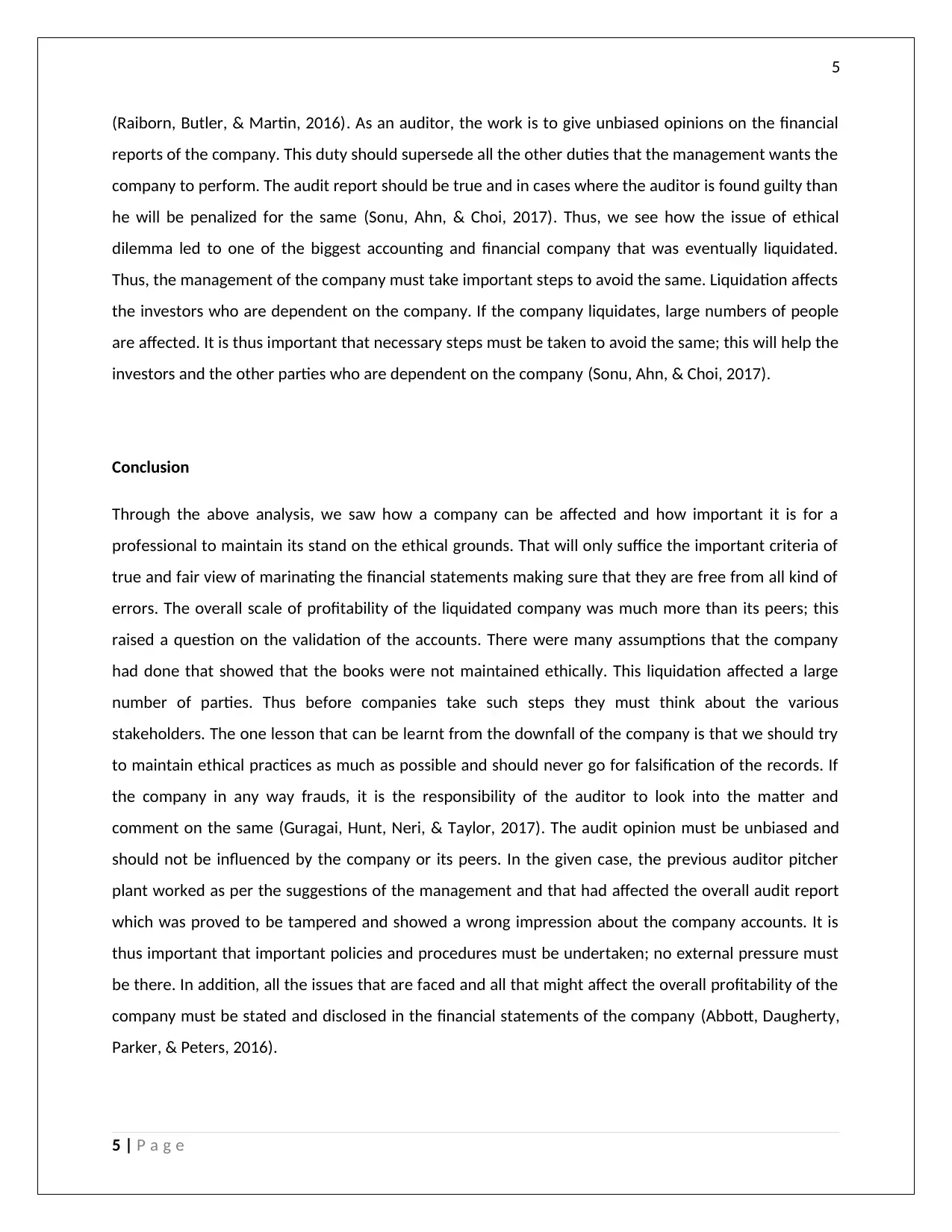
5
(Raiborn, Butler, & Martin, 2016). As an auditor, the work is to give unbiased opinions on the financial
reports of the company. This duty should supersede all the other duties that the management wants the
company to perform. The audit report should be true and in cases where the auditor is found guilty than
he will be penalized for the same (Sonu, Ahn, & Choi, 2017). Thus, we see how the issue of ethical
dilemma led to one of the biggest accounting and financial company that was eventually liquidated.
Thus, the management of the company must take important steps to avoid the same. Liquidation affects
the investors who are dependent on the company. If the company liquidates, large numbers of people
are affected. It is thus important that necessary steps must be taken to avoid the same; this will help the
investors and the other parties who are dependent on the company (Sonu, Ahn, & Choi, 2017).
Conclusion
Through the above analysis, we saw how a company can be affected and how important it is for a
professional to maintain its stand on the ethical grounds. That will only suffice the important criteria of
true and fair view of marinating the financial statements making sure that they are free from all kind of
errors. The overall scale of profitability of the liquidated company was much more than its peers; this
raised a question on the validation of the accounts. There were many assumptions that the company
had done that showed that the books were not maintained ethically. This liquidation affected a large
number of parties. Thus before companies take such steps they must think about the various
stakeholders. The one lesson that can be learnt from the downfall of the company is that we should try
to maintain ethical practices as much as possible and should never go for falsification of the records. If
the company in any way frauds, it is the responsibility of the auditor to look into the matter and
comment on the same (Guragai, Hunt, Neri, & Taylor, 2017). The audit opinion must be unbiased and
should not be influenced by the company or its peers. In the given case, the previous auditor pitcher
plant worked as per the suggestions of the management and that had affected the overall audit report
which was proved to be tampered and showed a wrong impression about the company accounts. It is
thus important that important policies and procedures must be undertaken; no external pressure must
be there. In addition, all the issues that are faced and all that might affect the overall profitability of the
company must be stated and disclosed in the financial statements of the company (Abbott, Daugherty,
Parker, & Peters, 2016).
5 | P a g e
(Raiborn, Butler, & Martin, 2016). As an auditor, the work is to give unbiased opinions on the financial
reports of the company. This duty should supersede all the other duties that the management wants the
company to perform. The audit report should be true and in cases where the auditor is found guilty than
he will be penalized for the same (Sonu, Ahn, & Choi, 2017). Thus, we see how the issue of ethical
dilemma led to one of the biggest accounting and financial company that was eventually liquidated.
Thus, the management of the company must take important steps to avoid the same. Liquidation affects
the investors who are dependent on the company. If the company liquidates, large numbers of people
are affected. It is thus important that necessary steps must be taken to avoid the same; this will help the
investors and the other parties who are dependent on the company (Sonu, Ahn, & Choi, 2017).
Conclusion
Through the above analysis, we saw how a company can be affected and how important it is for a
professional to maintain its stand on the ethical grounds. That will only suffice the important criteria of
true and fair view of marinating the financial statements making sure that they are free from all kind of
errors. The overall scale of profitability of the liquidated company was much more than its peers; this
raised a question on the validation of the accounts. There were many assumptions that the company
had done that showed that the books were not maintained ethically. This liquidation affected a large
number of parties. Thus before companies take such steps they must think about the various
stakeholders. The one lesson that can be learnt from the downfall of the company is that we should try
to maintain ethical practices as much as possible and should never go for falsification of the records. If
the company in any way frauds, it is the responsibility of the auditor to look into the matter and
comment on the same (Guragai, Hunt, Neri, & Taylor, 2017). The audit opinion must be unbiased and
should not be influenced by the company or its peers. In the given case, the previous auditor pitcher
plant worked as per the suggestions of the management and that had affected the overall audit report
which was proved to be tampered and showed a wrong impression about the company accounts. It is
thus important that important policies and procedures must be undertaken; no external pressure must
be there. In addition, all the issues that are faced and all that might affect the overall profitability of the
company must be stated and disclosed in the financial statements of the company (Abbott, Daugherty,
Parker, & Peters, 2016).
5 | P a g e
⊘ This is a preview!⊘
Do you want full access?
Subscribe today to unlock all pages.

Trusted by 1+ million students worldwide
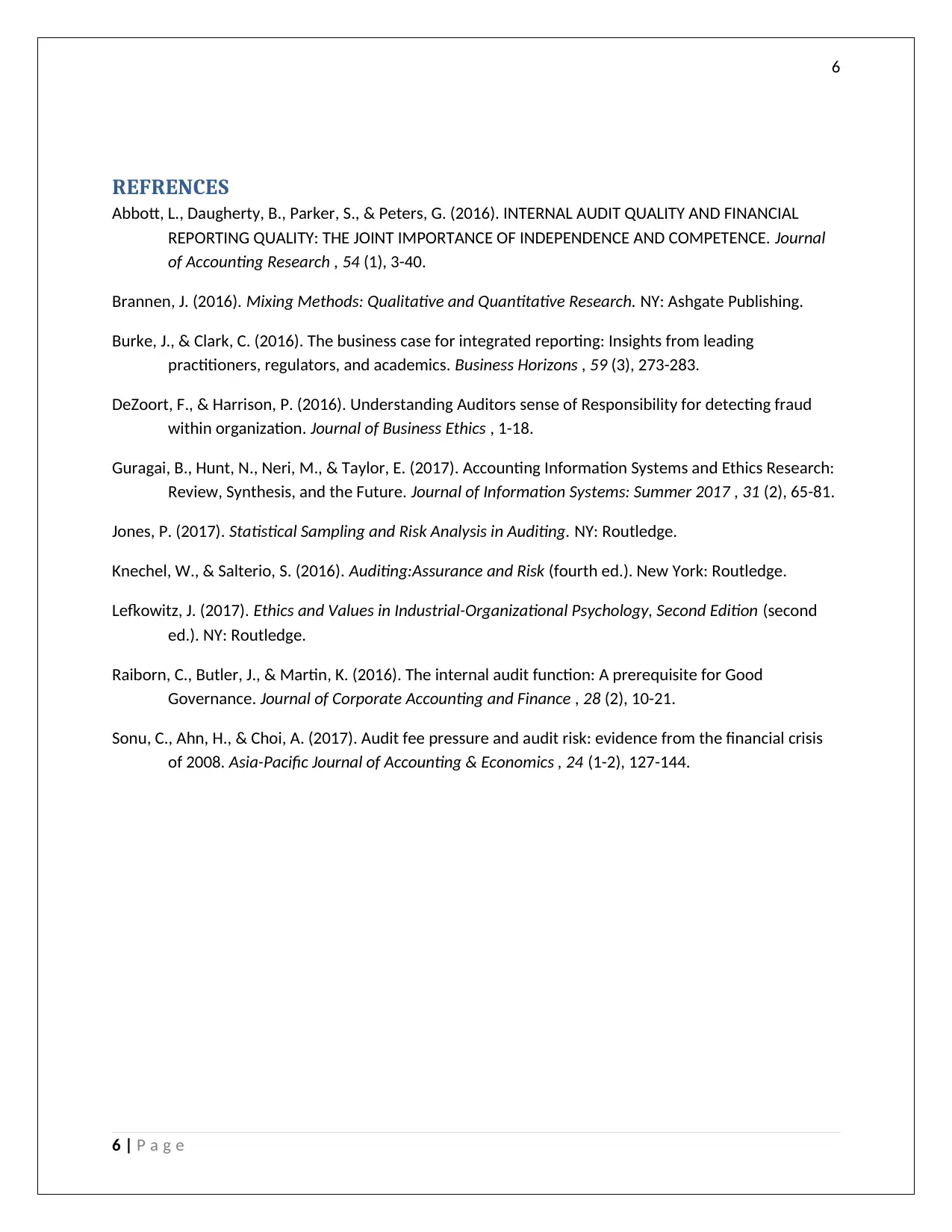
6
REFRENCES
Abbott, L., Daugherty, B., Parker, S., & Peters, G. (2016). INTERNAL AUDIT QUALITY AND FINANCIAL
REPORTING QUALITY: THE JOINT IMPORTANCE OF INDEPENDENCE AND COMPETENCE. Journal
of Accounting Research , 54 (1), 3-40.
Brannen, J. (2016). Mixing Methods: Qualitative and Quantitative Research. NY: Ashgate Publishing.
Burke, J., & Clark, C. (2016). The business case for integrated reporting: Insights from leading
practitioners, regulators, and academics. Business Horizons , 59 (3), 273-283.
DeZoort, F., & Harrison, P. (2016). Understanding Auditors sense of Responsibility for detecting fraud
within organization. Journal of Business Ethics , 1-18.
Guragai, B., Hunt, N., Neri, M., & Taylor, E. (2017). Accounting Information Systems and Ethics Research:
Review, Synthesis, and the Future. Journal of Information Systems: Summer 2017 , 31 (2), 65-81.
Jones, P. (2017). Statistical Sampling and Risk Analysis in Auditing. NY: Routledge.
Knechel, W., & Salterio, S. (2016). Auditing:Assurance and Risk (fourth ed.). New York: Routledge.
Lefkowitz, J. (2017). Ethics and Values in Industrial-Organizational Psychology, Second Edition (second
ed.). NY: Routledge.
Raiborn, C., Butler, J., & Martin, K. (2016). The internal audit function: A prerequisite for Good
Governance. Journal of Corporate Accounting and Finance , 28 (2), 10-21.
Sonu, C., Ahn, H., & Choi, A. (2017). Audit fee pressure and audit risk: evidence from the financial crisis
of 2008. Asia-Pacific Journal of Accounting & Economics , 24 (1-2), 127-144.
6 | P a g e
REFRENCES
Abbott, L., Daugherty, B., Parker, S., & Peters, G. (2016). INTERNAL AUDIT QUALITY AND FINANCIAL
REPORTING QUALITY: THE JOINT IMPORTANCE OF INDEPENDENCE AND COMPETENCE. Journal
of Accounting Research , 54 (1), 3-40.
Brannen, J. (2016). Mixing Methods: Qualitative and Quantitative Research. NY: Ashgate Publishing.
Burke, J., & Clark, C. (2016). The business case for integrated reporting: Insights from leading
practitioners, regulators, and academics. Business Horizons , 59 (3), 273-283.
DeZoort, F., & Harrison, P. (2016). Understanding Auditors sense of Responsibility for detecting fraud
within organization. Journal of Business Ethics , 1-18.
Guragai, B., Hunt, N., Neri, M., & Taylor, E. (2017). Accounting Information Systems and Ethics Research:
Review, Synthesis, and the Future. Journal of Information Systems: Summer 2017 , 31 (2), 65-81.
Jones, P. (2017). Statistical Sampling and Risk Analysis in Auditing. NY: Routledge.
Knechel, W., & Salterio, S. (2016). Auditing:Assurance and Risk (fourth ed.). New York: Routledge.
Lefkowitz, J. (2017). Ethics and Values in Industrial-Organizational Psychology, Second Edition (second
ed.). NY: Routledge.
Raiborn, C., Butler, J., & Martin, K. (2016). The internal audit function: A prerequisite for Good
Governance. Journal of Corporate Accounting and Finance , 28 (2), 10-21.
Sonu, C., Ahn, H., & Choi, A. (2017). Audit fee pressure and audit risk: evidence from the financial crisis
of 2008. Asia-Pacific Journal of Accounting & Economics , 24 (1-2), 127-144.
6 | P a g e
1 out of 7
Related Documents
Your All-in-One AI-Powered Toolkit for Academic Success.
+13062052269
info@desklib.com
Available 24*7 on WhatsApp / Email
![[object Object]](/_next/static/media/star-bottom.7253800d.svg)
Unlock your academic potential
Copyright © 2020–2025 A2Z Services. All Rights Reserved. Developed and managed by ZUCOL.





